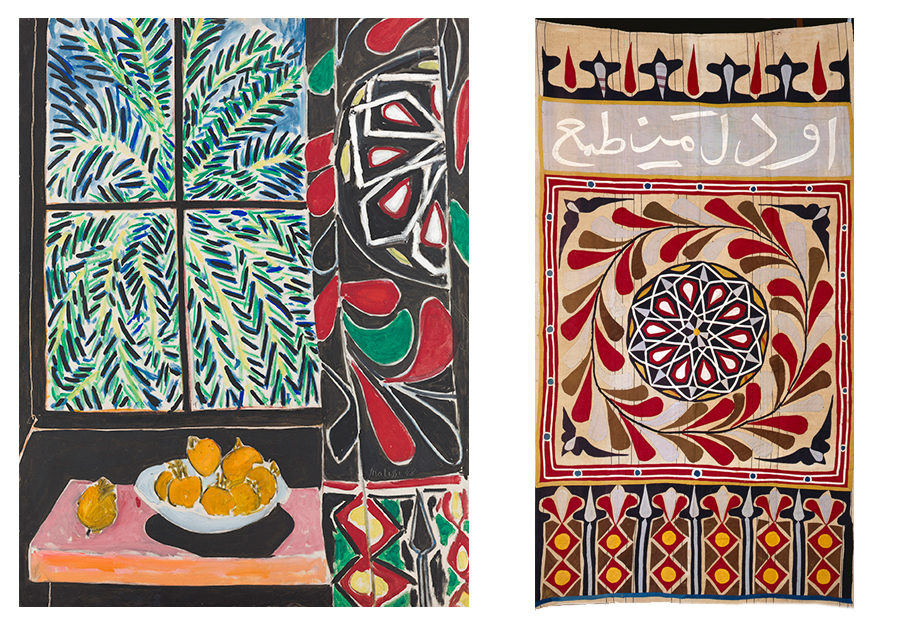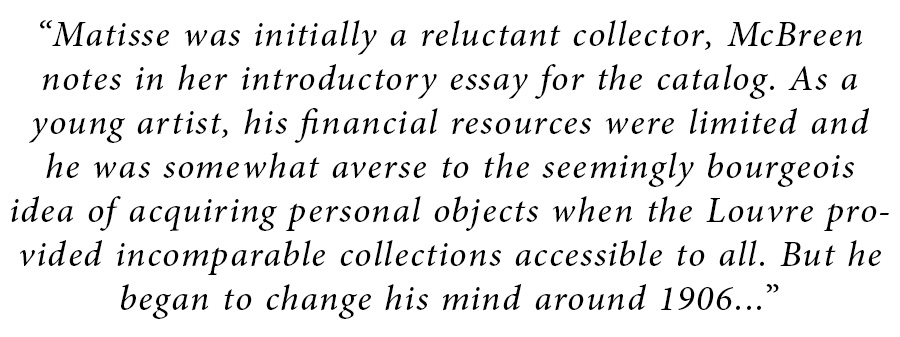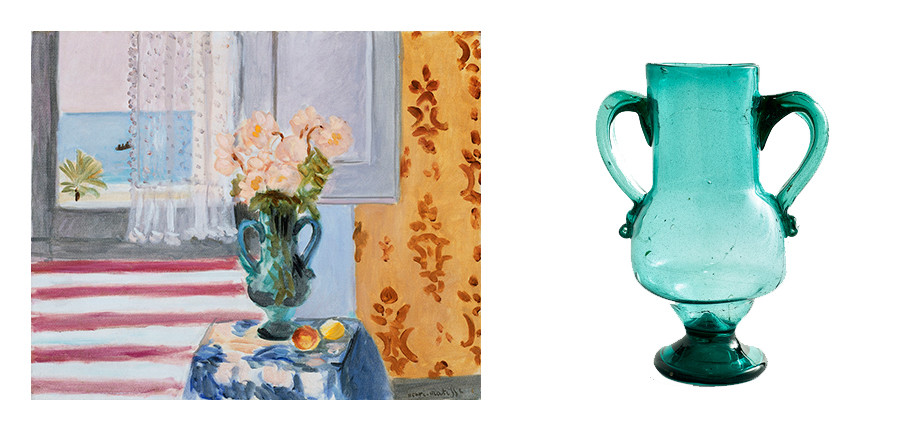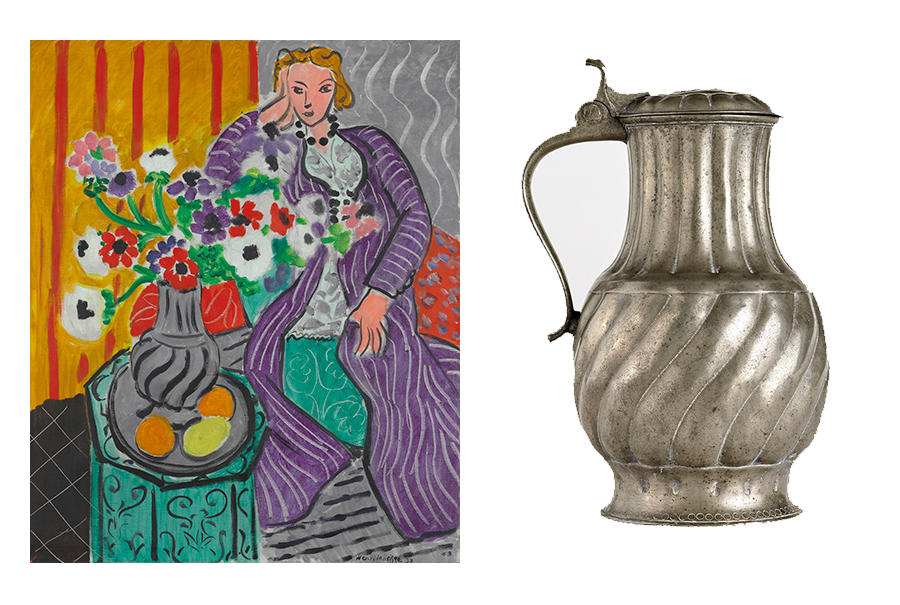
(Left) “Interior with Egyptian Curtain,” 1948. Oil on canvas. The Phillips Collection, Washington, DC.
(Right) Egyptian tent curtain (khayamiya), Nineteenth or early Twentieth Century. Cotton plain weave, appliquéd. Former collection of Henri Matisse. Private collection.
By Jessica Skwire Routhier
BOSTON – Henri Matisse, for many, is the quintessential Modernist painter – among the first to reduce observed reality to flat, abstracted colors and shapes. And yet, while Matisse helped to herald the sea change in art that made abstraction the norm after World War II, his own artistic practice was firmly rooted in the physical world, the world of things. Among those things were the humble, cherished objects he collected, kept in his studio and used repeatedly throughout his career as touchstones for his art. These objects – and the paintings, sculptures and paper cutouts they inspired – are the subjects of “Matisse in the Studio” at Boston’s Museum of Fine Arts (MFA) through July 9.
Matisse’s eclectic collection ranged from tribal African figures to Chinese porcelain garden seats to English tea caddies – an array of objects that would test the expertise of any single scholar on Matisse or on Modernist painting. In fact, none of the exhibition’s three co-curators is primarily a paintings person, at least not when it comes to Matisse. Helen Burnham is the MFA’s curator of prints and drawings; Ellen McBreen is a professor of art history at Wheaton College and the author of a recent book on Matisse’s sculpture; and Ann Dumas is the curator at the Royal Academy of Arts in London, where she organized an exhibition around Matisse’s textiles in 2005. “Matisse in the Studio” will travel to the Royal Academy in August.
McBreen notes that the team also relied heavily on a wide community of scholars in other fields, including decorative arts, Islamic arts and African tribal arts. The exhibition depended on the participation of the Musée Matisse in Nice, France, which received as a donation from the Matisse family many of the objects that appear and reappear, in various iterations, through Matisse’s vast body of work. Not only did the museum provide direct loans of many of the objects in the show, it also, with the family, helped the curators track down some of the African masks and figures that were foundational objects for Matisse. “The vast majority of those objects are from private collections,” McBreen notes. “Most of them have never before been exhibited in the United States – or anywhere.”
 The African pieces that Matisse collected, and the artworks that he produced in response to them, occupy a central section of the exhibition. Matisse was initially a reluctant collector, McBreen notes in her introductory essay for the catalog. As a young artist, his financial resources were limited and he was somewhat averse to the seemingly bourgeois idea of acquiring personal objects when the Louvre provided incomparable collections accessible to all. But he began to change his mind around 1906, when he spontaneously purchased, from a Parisian dealer, a small, seated Congolese Vili figure that, he then shared with both Gertrude Stein and Pablo Picasso.
The African pieces that Matisse collected, and the artworks that he produced in response to them, occupy a central section of the exhibition. Matisse was initially a reluctant collector, McBreen notes in her introductory essay for the catalog. As a young artist, his financial resources were limited and he was somewhat averse to the seemingly bourgeois idea of acquiring personal objects when the Louvre provided incomparable collections accessible to all. But he began to change his mind around 1906, when he spontaneously purchased, from a Parisian dealer, a small, seated Congolese Vili figure that, he then shared with both Gertrude Stein and Pablo Picasso.
In Matisse’s telling, that moment launched Picasso’s interest in African tribal arts and thus had a watershed effect on other Modernist painters. Matisse also remembered that he bought the sculpture for only 50 francs. The allure of the low investment and high return apparently energized his collecting habits thereafter. More important, this early acquisition helped African art to become a key influence on Matisse’s own artwork.
McBreen and Suzanne Preston Blier, a scholar of African art who contributed to the catalog, connect Matisse’s early portraiture to his interest in Congolese art. His “Self-Portrait” of 1906, for instance, like an African mask, is sculptural and stripped to the essentials, with no obvious signs of the modern world. McBreen connects such works to an interest in primitivism that would have encompassed not only non-Western art, but also pre-academic European medieval art, like a Thirteenth Century stone head of a saint that was also in Matisse’s collection.
In his paintings, Matisse often depicted many of his treasured objects quite literally – if in a somewhat simplified form – the same vase or coffee pot appearing, recognizably, over and over again. This is less true of the African masks and figures that he collected and the artwork they inspired. His 1909 sculpture “The Serpentine” adopts the pedestallike support seen in some Congolese sculptures, along with their polished brown surfaces, albeit in bronze instead of polished wood. And while something like his “Head of Jeannette” series – where a bronze female head becomes increasingly abstract – is not directly referential to any identifiable African work, it is allied to Matisse’s interest in primitivism through its progression to something elemental and iconlike.
Once completed, Matisse’s sculptures themselves became objects, and their presence in his studio also inspired him, creating enticing cultural and self-referential layers that scholars have delighted in peeling back. His bronze “Reclining Nude” of 1907, for instance, clearly inspired by African art, reappears in the painting “Goldfish and Sculpture” of 1912, where it takes on the peachy skin tone of an imagined Caucasian model. The work itself is a transitional one, with its brighter colors and suggestion of a view to the outside anticipating the exuberant work that he would produce in Nice, where he moved in 1918 and lived, off and on, for the rest of his life.

(Left) “Vase of Flowers,” 1924. Oil on canvas. Museum of Fine Arts, Boston; bequest of John T. Spaulding.All paintings and bronzes by Henry Matisse.
(Right) Vase, Andalusia, Spain, early Twentieth Century. Blown glass. Former collection of Henri Matisse. Musée Matisse, Nice; bequest of Madame Henri Matisse, 1960.
In Nice, Matisse established a fruitful connection with objects that had long been with him. A defining example from the MFA’s own collection is 1924’s “Vase of Flowers,” which features a green, handled glass vase from Andalusia, Spain. The vase itself was purchased in Granada during a trip Matisse took to Spain more than a decade before. He had included a sketch of the vase in a letter he wrote home to his wife, Amelie, enthusing about the area’s art and design, including the Alhambra and the nearby Great Mosque at Córdoba. Back in Nice, the vase served as a reminder of that eye-opening trip. Nice became the place where Matisse’s fascination with Islamic art and objects played out in his paintings.
The Nice paintings and related objects comprise another highlight of the show, occupying a central gallery cleverly designed by Chelsea Garunay as a Modernist interpretation of Islamic architecture. With its riot of colors, patterned textiles and bejeweled decorative objects, the room has mass crowd appeal – but, McBreen cautions, that has been part of the problem in analyzing this “misunderstood” period of Matisse’s career.
“While it’s so visually rich,” she says, “a lot of people, especially Matisse scholars, kind of think of it as a period when Matisse is sort of losing his edge – he makes all this difficult, challenging work up until the teens, and then he moves to Nice and starts painting odalisques in hotel rooms. We wanted the objects he used in that period to kind of question that assumption,” McBreen says. “It does remind us that Matisse is still really experimenting with ideas – he’s looking at the Haiti and borrowing ideas for abstraction – it’s just that the paintings themselves don’t wear their experimental qualities on their sleeves so clearly as earlier work.”

(Left) “Purple Robe and Anemones,” 1937. Oil on canvas. Baltimore Museum of Art, the Cone Collection.
(Right) Jug, northern France, late Eighteenth Century. Pewter. Former collection of Henri Matisse. Musée Matisse, Nice. Bequest of Madame Henri Matisse, 1960. —François Fernandez photo
The Haiti to which McBreen refers are a kind of North African textile with cut-out shapes, like the one visible in the background of “The Moorish Screen,” 1921, as part of a dazzlingly complex symphony of patterns. Matisse retained that interest in pattern, and in North African textiles specifically, as his style in Nice evolved. But his patterns progressively became more simplified, more elemental, both in line and color, as is evident in “Purple Robe and Anemones,” 1937, in which the model Lydia Delectorskaya appears, odalisquelike, in an abundantly patterned interior, curving around what looks like a vase filled with flowers. In fact, the vase is a pewter jug from Matisse’s collection, recognizable from its wave pattern of parallel lines, echoed in Delectorskaya’s robe, the wall behind her and the curves of her own body.
Within this network of sympathetic lines, placed side by side, the jug and the model seem to be almost like a couple, like equals within Matisse’s painted world. Indeed, scholars have often observed that Matisse paints objects as if they are living beings, with histories and personalities. Of “Purple Robe,” Matisse scholar Jack Flam writes in the catalog, “Everything in the painting calls and respond to everything else, and even the inanimate objects radiate an energy that seems to verge on consciousness.”
But how are we to regard Delectorskaya, then, who actually was a real, conscious person? If Matisse paints objects as if they were people, is it fair then to say that he also paints people as if they were objects? It is more complex than that, answers McBreen. “He’s trying to create an empathy among things in his studio, so that objects share in the energy of living beings and living beings share in the objects that are around them – everything becomes animated.”
McBreen connects this idea to the artist’s use of pattern. With the allover patterning in works like “Purple Robe” and others, it is hard to stay focused on, and thus fetishize, a central female figure, even when it is a nude. It is also possible to draw a parallel to the way Matisse plays with space in his works, something that he first starts exploring in earnest in Nice, where windows and mirrors and other reflective surfaces serve as frames and image-bearers, confusing interior and exterior views.
Looking back, then, at those gratifying Nice paintings, it is possible to appreciate them as sophisticated explorations of a similar quandary: what is subject and what is object? It was his lifelong interest in the magic of objects, in part, that enabled Matisse to approach that inquiry not only from a minimalist standpoint, but also from a maximalist one, where there is nothing – no thing – that is not relevant.
The Museum of Fine Arts is at 465 Huntington Avenue. For information, www.mfa.org or 617-267-9300.
Jessica Skwire Routhier is a writer, editor and independent art historian in South Portland, Maine












_henri_matisse.jpg)


_artist_unknown.jpg)





